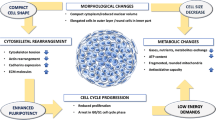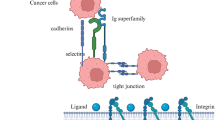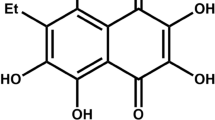Abstract
To elucidate the molecular mechanisms of resistance to detachment-induced apoptosis, we cultured BEL7402 hepatoma cells on plates coated with poly (2-hydroxyethyl methacrylate), which blocked access to the extracellular matrix. When BEL7402 hepatoma cells were suspended, they could self-assemble into aggregations and resist to detachment-induced apoptosis. Expression of TrkB on detached cells was much higher than that of attached ones. Protein structure analysis revealed that TrkB contained adhesion domain, which might contribute to the aggregation formation of hepatoma cells. These aggregations had higher proliferation indices with BDNF treatment. These data demonstrate that TrkB may contribute to metastasis by facilitating formation of multicellular aggregations and induce their resistance to detachment-induced apoptosis.




Similar content being viewed by others
Abbreviations
- BDNF:
-
Brain-derived neurotrophic factor
- CCK8:
-
Cell counting kit-8
- ECM:
-
Extra cellular matrix
- FCM:
-
Flow cytometry
- HCC:
-
Hepatocellular carcinoma
- LRR:
-
Leucine rich repeat
- Poly-HEMA:
-
Poly (2-hydroxyethyl methacrylate)
- SMART:
-
Simple Modular Architecture Research Tool
- TrkB:
-
Tropomyosin related kinase B
References
Rennebeck G, Martello M, Kyprianou N (2005) Anoikis and survival connections in the tumor microenvironment: is there a role in prostate cancer metastasis? Cancer Res 65:11230–11235. doi:10.1158/0008-5472.CAN-05-2763
Reddig PJ, Juliano RL (2005) Clinging to life: cell to matrix adhesion and cell survival. Cancer Metastasis Rev 24:425–439. doi:10.1007/s10555-005-5134-3
Geiger TR, Peeper DS (2005) The neurotrophic receptor TrkB in anoikis resistance and metastasis: a perspective. Cancer Res 65:7033–7036. doi:10.1158/0008-5472.CAN-05-0709
Vachon PH (2006) Cell survival: differences and differentiation. Med Sci (Paris) 22:423–429
Toruner M, Fernandez-Zapico M, Sha JJ, Pham L, Urrutia R, Egan LJ (2006) Antianoikis effect of nuclear factor-kappaB through up-regulated expression of osteoprotegerin, BCL-2, and IAP-1. J Biol Chem 281:8686–8696. doi:10.1074/jbc.M512178200
Frisch SM, Screaton RA (2001) Anoikis mechanisms. Curr Opin Cell Biol 13:555–562. doi:10.1016/S0955-0674(00)00251-9
Zhang Z, Cao L, Li J, Liang X, Liu Y, Liu H, et al (2008) Acquisition of anoikis resistance reveals a synoikis-like survival style in BEL7402 hepatoma cells. Cancer Lett 267:106–115. doi:10.1016/j.canlet.2008.03.010
Lykissas MG, Batistatou AK, Charalabopoulos KA, Beris AE (2007) The role ofneurotrophins in axonal growth, guidance, and regeneration. Curr Neurovasc Res 4:143–151. doi:10.2174/156720207780637216
Liang X, Liu Y, Zhang Q, Gao L, Han L, Ma C et al (2007) Hepatitis B virus sensitizes hepatocytes to TRAIL-induced apoptosis through Bax. J Immunol 178:503–510
Frisch SM, Francis H (1994) Disruption of epithelial cell-matrix interactions induces apoptosis. J Cell Biol 124:619–626. doi:10.1083/jcb.124.4.619
Zhang Y, Lu H, Dazin P, Kapila Y (2004) Squamous cell carcinoma cell aggregates escape suspension-induced, p53-mediated anoikis: fibronectin and integrin alphav mediate survival signals through focal adhesion kinase. J Biol Chem 279:48342–48349. doi:10.1074/jbc.M407953200
Zhu Z, Sanchez-Sweatman O, Huang X, Wiltrout R, Khokha R, Zhao Q et al (2001) Anoikis and metastatic potential of cloudman S91 melanoma cells. Cancer Res 61(4):1707–1716
Valentinis B, Reiss K, Baserga R (1998) Insulin-like growth factor-I-mediated survival from anoikis: role of cell aggregation and focal adhesion kinase. J Cell Physiol 176:648–657. doi:10.1002/(SICI)1097-4652(199809)176:3≤648::AID-JCP22≥3.0.CO;2-U
Shen X, Kramer RH (2004) Adhesion-mediated squamous cell carcinoma survival through ligand-independent activation of epidermal growth factor receptor. Am J Pathol 165:1315–1329
Douma S, Van Laar T, Zevenhoven J, Meuwissen R, Van Garderen E, Peeper DS (2004) Suppression of anoikis and induction of metastasis by the neurotrophic receptor TrkB. Nature 430:1034–1039. doi:10.1038/nature02765
Karakuziev TU (1977) Effect of gamma-irradiation on the pH and temperature stability of cotton seed phenylalanyl-tRNA-synthetases. Radiobiologia 17:292–294
Xiao S, McLean J, Robertson J (2006) Neuronal intermediate filaments and ALS: a new look at an old question. Biochim Biophys Acta 1762:1001–1012
Yang ZF, Ho DW, Lam CT, Luk JM, Lum CT, Yu WC et al (2005) Identification of brain-derived neurotrophic factor as a novel functional protein in hepatocellular carcinoma. Cancer Res 65:219–225
Yang ZF, Ho DW, Lau CK, Tam KH, Lam CT, Poon RT et al (2006) Platelet activation during tumor development, the potential role of BDNF-TrkB autocrine loop. Biochem Biophys Res Commun 346:981–985. doi:10.1016/j.bbrc.2006.06.007
Ho R, Eggert A, Hishiki T, Minturn JE, Ikegaki N, Foster P et al (2002) Resistance to chemotherapy mediated by TrkB in neuroblastomas. Cancer Res 62:6462–6466
Jaboin J, Kim CJ, Kaplan DR, Thiele CJ (2002) Brain-derived neurotrophic factor activation of TrkB protects neuroblastoma cells from chemotherapy-induced apoptosis via phosphatidylinositol 3′-kinase pathway. Cancer Res 62:6756–6763
Desmet CJ, Peeper DS (2006) The neurotrophic receptor TrkB: a drug target in anti-cancer therapy? Cell Mol Life Sci 63:755–759. doi:10.1007/s00018-005-5490-8
Han L, Zhang Z, Qin W, Sun W (2007) Neurotrophic receptor TrkB: is it a predictor of poor prognosis for carcinoma patients? Med Hypotheses 68:407–409. doi:10.1016/j.mehy.2006.05
Acknowledgements
This work was supported by grant from the Natural Science Foundation of China (No. 30700357) and grant from Natural Science Foundation of Shandong Province (No. Q2006C06).The authors gratefully acknowledge Prof. Youhai Chen (Department of Pathology and Laboratory Medicine, University of Pennsylvania, Philadelphia, PA, USA) for helpful discussion about this work.
Author information
Authors and Affiliations
Corresponding author
Additional information
Zhiyong Zhang and Lihui Han contributed equally to this work.
Rights and permissions
About this article
Cite this article
Zhang, Z., Han, L., Liu, Y. et al. Up-regulation of Tropomyosin related kinase B contributes to resistance to detachment-induced apoptosis in hepatoma multicellular aggregations. Mol Biol Rep 36, 1211–1216 (2009). https://doi.org/10.1007/s11033-008-9299-z
Received:
Accepted:
Published:
Issue Date:
DOI: https://doi.org/10.1007/s11033-008-9299-z




